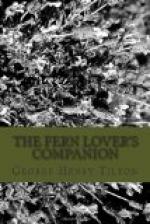In identifying this fern the novice should bear in mind the tendency of the curved sori of youth to become straightened and even confluent with age, although such changes are rather unreliable. Possibly the suggestion of the poetic Davenport may be helpful to some that there is “An indefinable charm about the various forms of the lady fern, which soon enables one to know it from its peculiarly graceful motion by merely gently swaying a frond in the hand.” Spores ripen in August.
The lady fern is very easy to cultivate and when once established is apt to crowd aside its neighbors.
(3) SILVERY SPLEENWORT. ATHYRIUM ACROSTICHOIDES
Asplenium acrostichoides. Asplenium thelypteroides
Fronds two to four feet tall, pinnate, tapering both ways from the middle. Pinnae deeply pinnatifid, linear-lanceolate, acuminate. Lobes oblong, obtuse, minutely toothed, each bearing two rows of oblong or linear fruit-dots. Indusium silvery when young.
[Illustration: Silvery Spleenwort. Athyrium acrostichoides]
[Illustration: Silvery Spleenwort. Athyrium acrostichoides]
The sterile fronds come up first and the taller, fertile ones do not appear until late in June. Where there are no fruit-dots the hairs on the upper surface of the fronds will help to distinguish it from specimens of the Marsh fern tribe, which it somewhat resembles. The regular rows of nearly straight, clear-cut sori of the fertile fronds are very attractive, and the lower ones, as well as those at the slender tips of the pinnae, are frequently double.
Rich woods and moist, shady banks, New England to Kentucky and westward. Generally distributed but hardly common.
(4) NARROW-LEAVED SPLEENWORT
ATHYRIUM ANGUSTIFOLIUM. Asplenium angustifolium
Fronds one to four feet tall, pinnate. Pinnae numerous, thin, short-stalked, linear-lanceolate, acuminate, those of the fertile fronds narrower. Fruit-dots linear. Indusium slightly convex.
[Illustration: Narrow-leaved Spleenwort. Athyrium angustifolium (Vermont) (Geo. E. Davenport)]
In rich woods from southern Canada and New Hampshire to Minnesota and southward. September. Not common. Mt. Toby, Mass., Berlin and Meriden, Conn., and Danville, Vt. Can be cultivated but should not be exposed to severe weather, as its thin and delicate fronds are easily injured. Woolson writes of it, “There is nothing in the fern kingdom which looks so cool and refreshing on a hot day as a mass of this clear-cut, delicately made-up fern.”
[Illustration: Pinnae and Sori of Athyrium angustifolium]
HART’S TONGUE
Scolopendrium. PHYLLITIS
Sori linear, a row on either side of the midvein, and at right angles to it, the indusium appearing to be double. (Scolopendrium is the Greek for centipede, whose feet the sori were thought to resemble. Phyllitis is the ancient Greek name for a fern.) Only one species in the United States.




